
Lampang is one of Thailand's seventy-six provinces (changwat), lies in upper northern Thailand. The old name of Lampang was Khelang Nakhon.

Phra Nakhon is one of the 50 districts (khet) of Bangkok, Thailand. It is the central district of Bangkok, including Rattanakosin Island. Neighboring districts are, from the north, clockwise: Dusit, Pom Prap Sattru Phai, Samphanthawong, and across the Chao Phraya River, Thon Buri, Bangkok Yai, Bangkok Noi, and Bang Phlat.
The Dhammakaya tradition or Dhammakaya movement, sometimes spelled as Thammakaai movement, is a Thai Buddhist tradition founded by Luang Pu Sodh Candasaro in the early 20th century. It is associated with several temples descended from Wat Paknam Bhasicharoen in Bangkok.
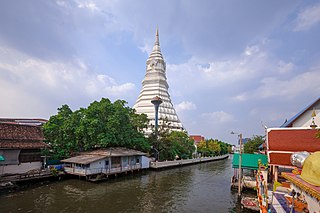
Wat Paknam Bhasicharoen is a royal wat ('temple') located in Phasi Charoen district, Bangkok, at the Chao Phraya River. It is part of the Maha Nikaya fraternity and is the origin of the Dhammakaya tradition. It is a large and popular temple, supported by prosperous community members.
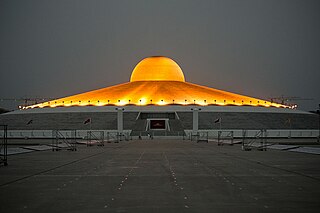
Wat Phra Dhammakaya is a Buddhist temple (wat) in Khlong Luang district, in the Pathum Thani province north of Bangkok, Thailand. It was founded in 1970 by the maechi (nun) Chandra Khonnokyoong and Luang Por Dhammajayo. It is the best-known and the fastest growing temple of the Dhammakaya tradition. This tradition, teaching Dhammakaya meditation, was started by the meditation master Luang Pu Sodh Candasaro in the early-20th century. Wat Phra Dhammakaya is one of the temples that emerged from this tradition and is part of the Mahā Nikāya fraternity. The temple is legally represented by the Dhammakaya Foundation. It aims to adapt traditional Buddhist values in modern society, doing so through modern technology and marketing methods. The temple has faced controversy and a government crackdown. Wat Phra Dhammakaya plays a leading role in Thai Buddhism, with theologian Edward Irons describing it as "the face of modern Thai Buddhism".
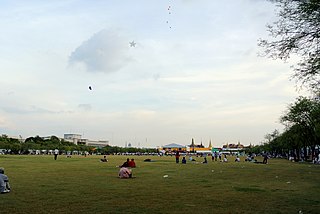
Sanam Luang is a 74.5 rai (119,200 m2) open field and public square in front of Wat Phra Kaew and the Grand Palace, Bangkok, Thailand. Sanam Luang is in the Phra Nakhon District, the historic center of Bangkok.

Tha Phra Chan is a pier on Rattanakosin Island, Bangkok, on the east bank of the Chao Phraya River, in Phra Nakhon District. The pier is beside Thammasat University's campus of the same name. Tha Phra Chan literally means 'moon pier'. More broadly, the name also refers to the area around the pier and the university. The area is also known as a marketplace for Thai amulets and astrologers. It is also full of shops, book stores, restaurants, and food stalls.

The Bangkok National Museum is the main branch museum of the National Museums in Thailand and also one of the largest museums in Southeast Asia. It features exhibits of Thai art and history. It occupies the former palace of the vice king, set between Thammasat University and the National Theater, facing Sanam Luang.

Siri Rat is one of the 180 sub-districts (khwaeng) of Bangkok, Thailand, covering the area around Siriraj Hospital, located on the southern rim of Khlong (canal) Bangkok Noi mouth to the western bank of the Chao Phraya River in Bangkok Noi District. It is also named for the road intersection of Thanon (Road) Arun Ammarin and Thanon Wang Lang at the front of the hospital.
Bangkok, the capital of Thailand, is one of the world's top tourist destination cities. Each year, approximately 22.7 million international visitors arrive in Bangkok. MasterCard ranked Bangkok as the world's top destination city, with 15.98 million projected visitors in 2013. It topped the MasterCard Global Destinations Cities Index as the most visited city in the world in 2012, 2013, 2016, 2017 and 2018. The city is ranked fourth in cross-border spending, with 14.3 billion dollars projected for 2013, after New York, London and Paris. Euromonitor International ranked Bangkok sixth in its Top City Destinations Ranking for 2011. Bangkok has also been named "World's Best City" by Travel + Leisure magazine's survey of its readers for four consecutive years since 2010.
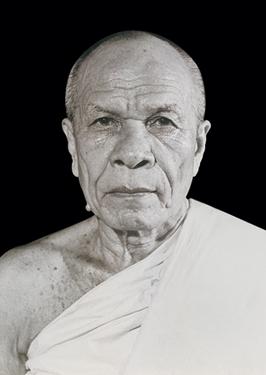
Luang Pu Sodh Candasaro, also known as Phramongkolthepmuni, was a Thai Buddhist monk who served as the abbot of Wat Paknam Bhasicharoen from 1916 until his death in 1959. He founded the Thai Dhammakāya school in the early 20th century. As the former abbot of Wat Paknam Bhasicharoen, he is often called Luang Pu Wat Paknam, meaning 'the Venerable Father of Wat Paknam'. He became a well-known meditation master during the interbellum and the Second World War, and played a significant role in developing Thai Buddhism during that period. He is considered by the Dhammakaya tradition to have rediscovered Vijja Dhammakaya, a meditation method believed to have been used by the Buddha himself. Since the 2000s, some scholars have pointed out that Luang Pu Sodh also played an important role in introducing Theravāda Buddhism in the West, a point previously overlooked.

The Front Palace, officially the Phraratchawang Bowon Sathanmongkhon (พระราชวังบวรสถานมงคล), was the residence of the royal holder of the same title during the early-to-mid Rattanakosin Kingdom. The palace was built at the same time as the Grand Palace, following the accession of King Rama I and the foundation of Rattanakosin as the capital city in 1782. It was located at the northern end of the inner fortified city, directly in front of the Grand Palace, where the king lived, and provided security to the city.
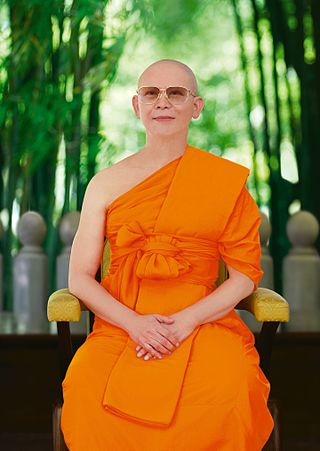
Luang Por Dhammajayo, also known by the lay name Chaiyabun Suddhipol, is a Thai Buddhist monk. He was the abbot of the Buddhist temple Wat Phra Dhammakaya, the post he held until 1999 and again from 2006 to December 2011. In December 2016, he was given the post of honorary abbot of the temple. He is a student of the nun (maechi) Chandra Khonnokyoong, and is the most well-known teacher of Dhammakaya meditation. He has been subject to criticism and government response. However, he continues to be a spiritual leader that has significant influence in Thai society. Luang Por Dhammajayo's approach to Buddhism seeks to combine the ascetic and meditative life with modern personal ethics and social prosperity.

Rama IV Road is a main road in Bangkok, Thailand. It starts at Mo Mi Junction in the area of Bangkok's Chinatown in Samphanthawong and Pom Prap Sattru Phai Districts and ends at the junction with Sukhumvit Road in Khlong Toei District near Bangkok Port, also known as Khlong Toei Port.

Wat Phra Dhammakaya is a Buddhist temple in Thailand. It was founded in 1970 by the maechi (nun) Chandra Khonnokyoong and Luang Por Dhammajayo. The temple's founding has roots in the Dhammakaya tradition founded by Luang Pu Sodh Candasaro at Wat Paknam Bhasicharoen in the early 20th century. Wat Phra Dhammakaya is known for its modern dissemination methods and use of technology.

Bang Lamphu or spelled Banglampoo and Banglamphu is a neighbourhood in Bangkok located in Phra Nakhon District. The history of the Bang Lamphu community dates to the establishment of the Rattanakosin Kingdom, or earlier. Bang Lamphu covers an area north of Phra Nakhon in Rattanakosin Island from Phra Athit Road to Samsen Road, which leads toward Dusit District.

Wat Bowon Sathan Sutthawat is a Thai temple in Bangkok. It's a historic temple in the area of the Front Palace, similar to Wat Phra Kaew inside the Grand Palace. Because the temple is situated in a palace, no monks live inside it. The temple is located at 4 Rachini Road, Phra Borom Maha Ratchawang Subdistrict, Phra Nakhon District, Bangkok within Bunditpatanasilpa Institute in front of foot of Phra Pinklao Bridge opposite the entrance of Soi Rambuttri near Tha Chang Wang Na and Bangkok Tourism Division, Culture, Sports and Tourism Department, next to the National Theater. This temple is also known as Wat Phra Kaew Wang Na.

Tha Chang, or well known in Thai Tha Chang Wang Luang, with designated pier code N9, is a pier on Chao Phraya River located on the end of Na Phra Lan Road in the area behind Grand Palace next to Nagaraphirom Park and Ratchaworadit Pier.

Charan Sanit Wong Road is a main road in Bangkok's Thonburi side, it is named in honour of Luang Charan Sanit Wong, the former Permanent Secretary, Ministry of Transport. Its name has been misspelled as จรัลสนิทวงศ์ in Thai according to the 1999 Royal Institute Dictionary.

Rachini Road is a road in inner Bangkok, located in Phra Borom Maha Ratchawang Subdistrict of Phra Nakhon District.

















